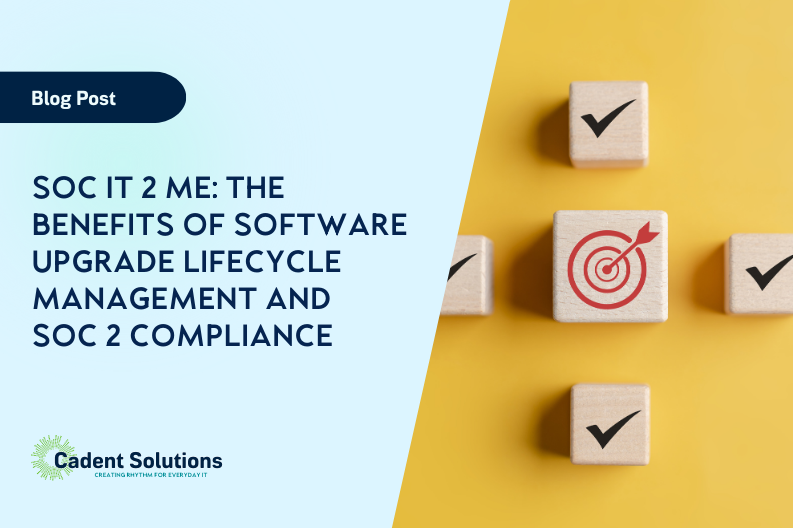SOC it 2 Me: The Benefits of Software Upgrade Lifecycle Management and SOC 2 Compliance
There are many reasons to maintain your network operating system software, from patching to upgrading to the latest versions. But as IT professionals, we know this is easier said than done. We have to be concerned with adequate testing and validation, compatibility of the update with other technologies within the stack, maintenance planning, and overall impact on the organization.
So often network operating system updates can fall by the wayside. But we also understand we must continuously evolve IT infrastructure to remain secure, efficient, and compliant.
One critical aspect of IT governance is Software Upgrade Lifecycle Management—a structured approach to keeping software updated through patches, upgrades, and version transitions. This practice is not just about maintaining performance but is essential for meeting compliance standards like SOC 2 (Service Organization Control 2), which ensures robust security and data protection.
What is Software Upgrade Lifecycle Management?
Software Upgrade Lifecycle Management refers to the systematic process of managing software updates, from initial development and testing to deployment and monitoring. This includes:
- Intelligent Awareness – Proactively understanding where the software is in comparison to the vendor’s release notifications, vulnerability patches, and other relevant notifications.
- Risk Management – Applying security and functionality updates to mitigate vulnerabilities.
- End-of-Life (EOL) Planning – Replacing outdated software before it becomes a security liability.
- Automated Updates – Using automation to ensure timely and consistent patch deployment.
Why Software Upgrades Matter for SOC 2 Compliance
SOC 2 compliance is focused on the five Trust Service Criteria (TSC): Security, Availability, Processing Integrity, Confidentiality, and Privacy. Neglecting software upgrades can put your organization at risk of violating these principles.
Here is a reminder of the key benefits of Software Upgrade Lifecycle Management in achieving SOC 2 compliance:
1. Enhanced Security Against Cyber Threats
Outdated software often contains security vulnerabilities that cybercriminals exploit. Regular updates ensure known security flaws are patched, reducing the attack surface and ensuring compliance with security best practices.
2. Improved System Availability and Performance
System downtime due to crashes or performance degradation can disrupt operations. A well-managed upgrade process enhances system stability, ensuring continuous service availability.
3. Proactive Risk Mitigation
Organizations must assess and mitigate risks associated with outdated software. By maintaining an upgrade lifecycle, businesses proactively manage security risks rather than reacting to incidents after a breach.
4. Compliance with Regulatory and Industry Standards
Many regulatory frameworks (e.g., GDPR, HIPAA, PCI-DSS) emphasize securing, up-to-date software. Implementing lifecycle management helps organizations maintain compliance across multiple standards.
5. Cost Savings and Operational Efficiency
Delaying software upgrades can lead to expensive emergency fixes, downtime, or security breaches. A proactive approach to software lifecycle management reduces long-term IT costs and improves efficiency.
Best Practices for Effective Software Upgrade Lifecycle Management
To fully leverage software upgrades for SOC 2 compliance, it is recommended to:
- Develop a Patch Management Policy – Define timelines and responsibilities for applying patches.
- Automate Updates – Use tools like WSUS, SCCM, or cloud-native solutions for consistent deployment.
- Perform Regular Vulnerability Scans – Identify and address outdated components before they become a liability.
- Maintain an Asset Inventory – Keep track of software versions and lifecycle stages to ensure proactive updates.
- Implement a Change Management Process – Test and validate updates before rolling them out to production systems.
Conclusion
Software Upgrade Lifecycle Management is not just an IT best practice—it is a critical component of maintaining SOC 2 compliance. By prioritizing software updates, organizations can enhance security, ensure regulatory compliance, reduce risks, and improve operational efficiency. Investing in a structured upgrade strategy today can prevent costly security breaches and compliance failures in the future.
By integrating a disciplined approach to software upgrades, businesses can demonstrate their commitment to security and data protection—building trust with clients and stakeholders while staying ahead of evolving cyber threats.
CADENT SOLUTIONS HAS THE EXPERTISE TO ASSIST YOU WITH YOUR IT PROCEDURE MANAGEMENT. CONTACT US FOR A COMPLIMENTARY ASSESSMENT OF YOUR BUSINESS PROCESSES AND NETWORK INFRASTRUCTURE UPGRADE NEEDS.

